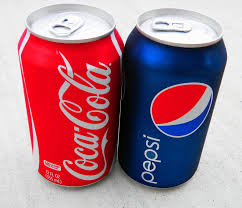Where Coke and Pepsi Compete for Burps

The Mexican state of Chiapas is located in the nation’s south, bordering Guatemala and the Pacific ocean. Among the many indigenous people of the area are the Tzotzil, about 300,000 strong who live primarily in an area known as Chamula. When it comes to religious rituals, the Tzotzil’s start by resembling those of many other cultures — with one unique addition. In 2008, a New York Times writer traveled to Chiapas and reported on the customs:
Inside the church of San Juan de Chamula, a fine cloud of smoke filled the air. It rose in wisps from hundreds of thin, white candles, perched delicately on the floor in ranks of 5, 10, 20, 40. Scattered around them lay a loose carpet of pine needles, the green arcs overlapping in dizzying patterns. The scents of pine resin, melted wax and burning wick mingled in my nose, and the chanted prayers of the indigenous Chamulans [who are of Tzotzilan ethnicity] — who knelt before the candles, with bottles of Coca-Cola and pox, a homemade sugar-cane liquor pronounced posh, at their sides — made me feel as if I’d entered another, more mysterious universe.
Candles, pine needles, homemade libations, and — wait, Coca-Cola?
Yes, Coca-Cola — it’s there for the burps. The Tzotzil people believe that when you burp, you release the Devil from inside you — and, therefore, one should burp heartily and often. And as a result, the Tzotzil have become a battleground in the multinational soda wars between Coke and Pepsi.
Because of the burping beliefs, the Tzotzil have adopted colas as part of their religious practices and part of their daily lives — often to an extreme result. In 2006, In These Times reported that “beverages sell for 50 U.S. cents a can, exactly the average daily income” and observed that “purchasing a soda often means not purchasing food, and Chiapas has one of the highest rates of both malnutrition and Coke consumption in Mexico.”
With such demand, though, the cola companies can’t help themselves. A travel writer for the Independent visited the region in 1997 and noticed that the Coke/Pepsi battle for market supremacy was unavoidable:
Adverts bombard visitors in the fight for brand loyalty from the moment you enter the village. A painted Coca-Cola bottle on a whitewashed wall promises siempre mejor [“always the best”]. Immediately behind it, a Pepsi-sponsored billboard advises us not to take photographs during religious rituals. Stories still circulate about two American tourists who were supposedly killed after taking photographs inside Chamula’s church during a ritualistic ceremony. [That double murder probably didn’t happen; it’s widely believed among Chamulans to be fiction.]
And the battle for soda supremacy probably does not stop at advertisements. With local shamans controlling a lot of consumption choices — especially for the carbonated cola choice for religious rituals — there’s an obvious produce placement opportunity to be had. And, as one may have feared, there are some reports that the the Coca-Cola company paid some of these shamans to make Coke their brand of choice — and that Pepsi responded in kind, with offers of payments of their own.
And to make matters worse, the soft drinks are often used to procure political support. The “local elites who wield economic and political power and control the soft drink concession” or “caciques,” in the words of In These Times, have used the religiously-driven appeal of Coke (or Pepsi) to ensure politics success:
A few months before each election, caciques begin providing store owners with all their cola products free of charge. In exchange, each store owner will support his cacique-sponsor’s preferred candidate in the local election, which is invariably a choice between two politicians from the Institutionalized Revolutionary Party (PRI). In turn, the customers of each store get all the cola they want for free, provided they vote for the owner’s candidate. This arrangement helps both the caciques and the PRI to retain their hold on power.
The good news? According to a 2004 report by the Atlanta Journal-Constitution (republished here), when children in the Tzotzilan communities fall ill, parents may use the cola to get the kids to burping, “expelling the sickness,” but they don’t do so as a substitute for medical advice — they also go to the doctor.
 Bonus Fact: Coca-Cola was the first soft drink in space, with trips on three different Space Shuttles and to Mir. But drinking soda in space? It’s a bad idea. According to NASA’s K-12 website, NASA Quest, the burps are a problem: “Because there is no gravity, the contents of your stomach float and tend to stay at the top of your stomach, under the rib cage and close to the valve at the top of your stomach. Because this valve isn’t a complete closure (just a muscle that works with gravity), if you burp, it becomes a wet burp from the contents in your stomach.” Yuck.
Bonus Fact: Coca-Cola was the first soft drink in space, with trips on three different Space Shuttles and to Mir. But drinking soda in space? It’s a bad idea. According to NASA’s K-12 website, NASA Quest, the burps are a problem: “Because there is no gravity, the contents of your stomach float and tend to stay at the top of your stomach, under the rib cage and close to the valve at the top of your stomach. Because this valve isn’t a complete closure (just a muscle that works with gravity), if you burp, it becomes a wet burp from the contents in your stomach.” Yuck.
From the Archives: Vodka and Cola: Crystal Pepsi and White Coke — and a Cold War work-around.
Take the Quiz: Coke versus Pepsi: Name Their Products
Related: A hide-a-key safe which looks like a can of soda. In fairness to both Pepsi and Coke, that link goes to an A&W Root Beer can.
